Working with Partners on Rare Habitats
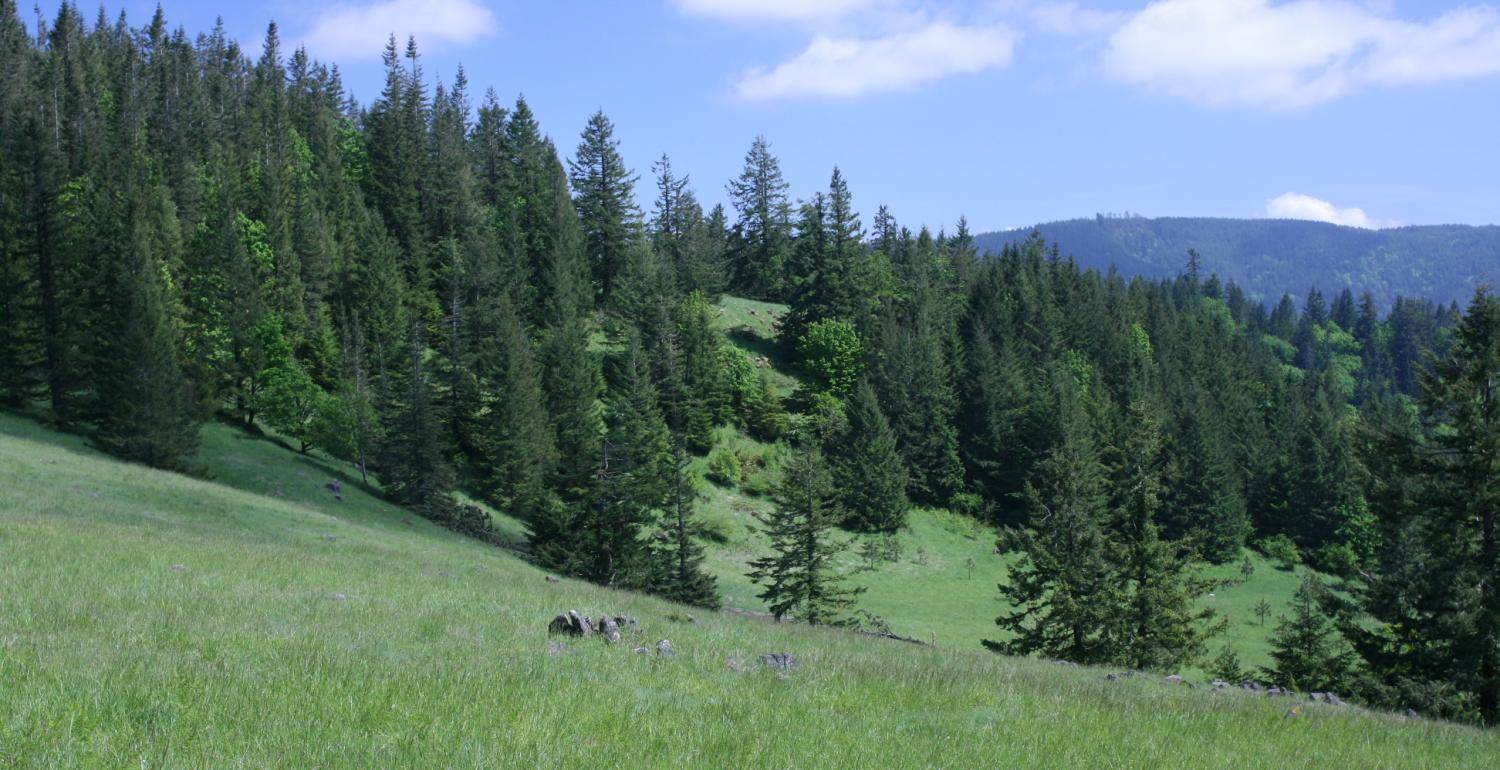
This article, by Jim Merzenich of Oak Basin Tree Farm, was first published in the Fall 2020 edition of Northwest Woodlands, a publication of the Oregon Small Woodlands, Washington Farm Forestry, Idaho Forest Owners & Montana Forest Owners Associations. Northwest Woodlands magazine is a benefit of membership in one of these associations – click on the links above to learn more and join! The article is reprinted with permission. Oak Basin Tree Farm is a member of NNRG’s group FSC® certificate.
By Jim Merzenich
Oregon white oak (Quercus garryana) stands are some of the rarest natural habitats in the Northwest. Oak Basin Tree Farm contains some of the largest intact parcels of oak remaining in the Willamette Valley, with some pre-settlement stands exceeding two hundred years of age.
Oak Basin is home to the endangered Fender’s blue butterfly and other rare plant and vertebrate species associated with oak and native prairie. We are actively restoring these areas by removing the competing vegetation, mowing the brush, doing selective cattle grazing and reestablishing native grasses and forbs.
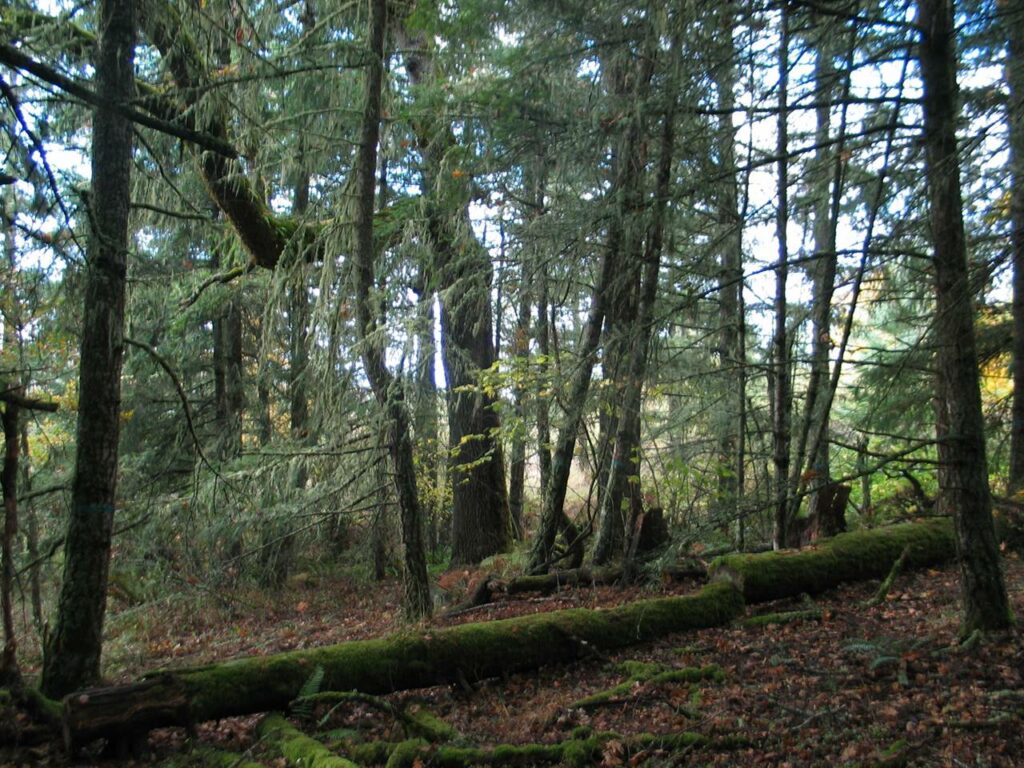
Our primary objective is to demonstrate that a sustainable flow of harvestable timber can be produced from property that is managed for native species protection. We believe that habitat protection is best achieved by active management. We strive to be an example to others that management can be ecologically sustainable while returning profits and services to the landowner.
Soon after my brother Ed purchased the initial Oak Basin acreage, he received a “repair order” from the state of Oregon. As the new owner he was required to immediately reforest over four hundred cutover acres. We proceeded to plant Douglas-fir on the better ground and ponderosa pine on areas that would not support fir. After paying more for reforestation than for the property, Ed was recognized as the Linn County Tree Farmer of the Year in 1998. My wife and I became part owners of Oak Basin when we purchased adjacent timberland in 2004.
When we evaluated our joint properties in 2005, we were ignorant of the importance of oak habitat and wondered what to do with the third of our ownership (over 300 acres) that was in brush and meadows. There was interest in restoring oak woodlands and the U.S. Fish and Wildlife Service (FWS) was the major source of funding.
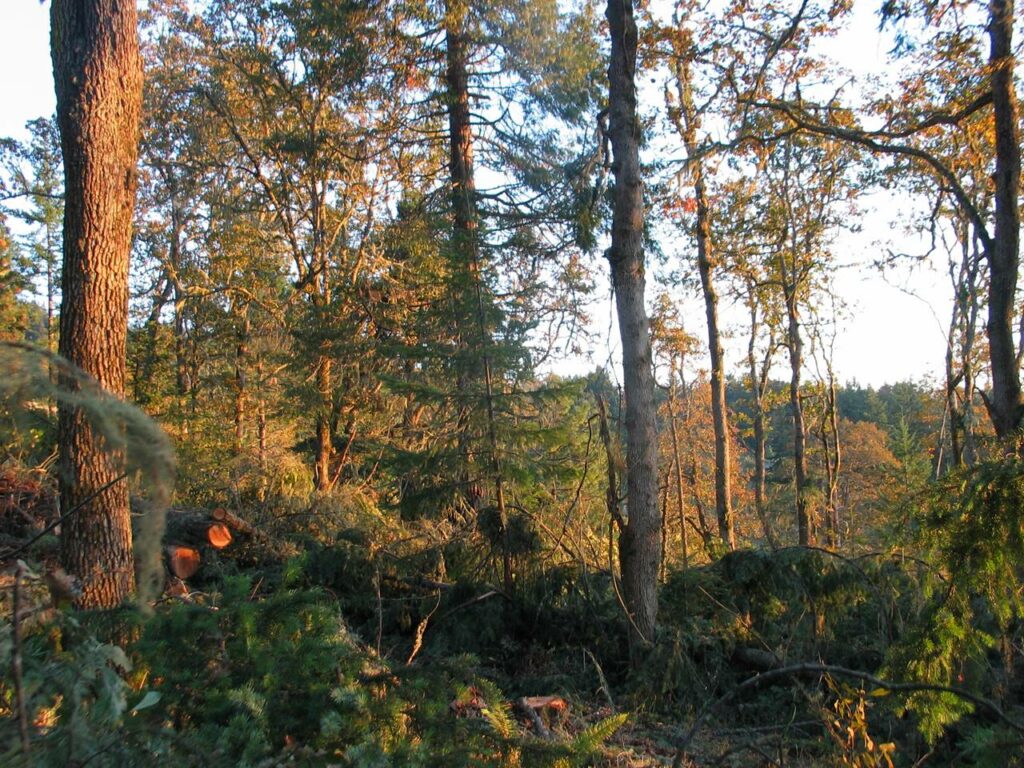
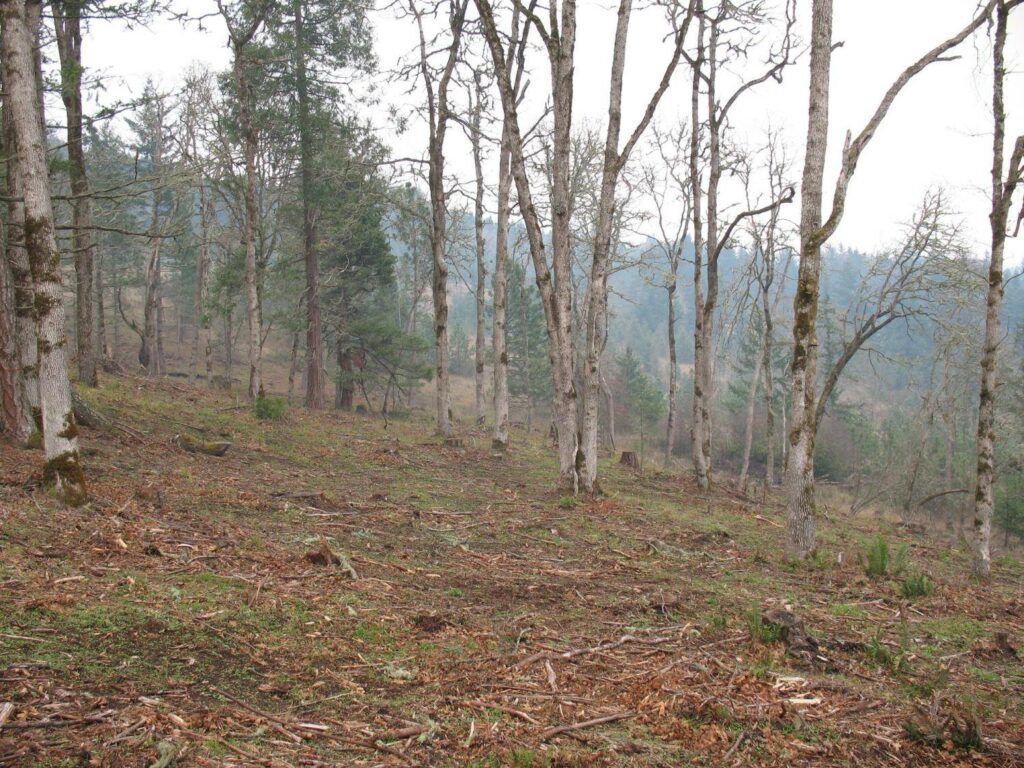
After consulting with the FWS our first project was mowing and spraying non-native blackberries and hawthorn growing in our meadows and oak stands. We were reimbursed for half of the cost of mowing up to a limit of $10,000 each. With the prickly vines gone, we could suddenly access and use areas that were unknown to us prior to treatment. The change to our landscape was profound and this transformation inspired us to do more. We soon purchased our own Cat® skid steer with mower, grapple and shear attachments and have been busy doing our own restoration.
In 2007, we signed our first “Partners for Wildlife” agreement. In this program, the FWS shares the expenses for ecological restoration activities that benefit wildlife. This has enabled us to restore many acres that were otherwise uneconomical to treat. Our Partners agreement was extended for another ten years in 2019. In 2016, my wife and I were invited to a national meeting in North Platte, Nebraska where we heard from partners managing longleaf pine and red-cockaded woodpeckers in Alabama, cattle and grizzlies in Montana and tall grass prairies in Kansas. The common theme of this meeting was that once-common habitats are now considered rare and valuable.
Prior to European settlement, oak woodlands and native prairie dominated inland valleys of western Oregon and Washington. Due to land conversion and fire suppression, less than five percent of the historic oak and prairie habitat remains. Historically, oak stands were maintained by frequent aboriginal burning, which kept most of the underbrush and fire sensitive trees like Douglas-fir under control. In the absence of fire, Douglas-fir invades these stands and eventually overtops and kills the oak. Noxious shrubs, such as non-native blackberries, hawthorn and Scotch broom invade and dominate the understories. In the native understory, Roemer’s fescue (akin to Idaho fescue), blue wildrye and California fescue are dominant along with poison oak, snowberry and serviceberry.
To restore these stands, we remove the fir, thin the oak and control the brush. Habitat maintenance requires noxious weed control and
periodic burning, when allowed. Grazing may be used to mimic the effect of fire and reduce wildfire risk. Drought resistant conifers, such as ponderosa pine and incense cedar, may be replanted among the oaks in areas that can support them. Oregon white oak generally grows on the poorest sites. The conifer logs taken from these sites are of low quality with high taper and defect. By playing the markets, we have made a small profit removing the fir. We now spend our limited timber management dollars on our productive ground, not on relatively unproductive oak stands.
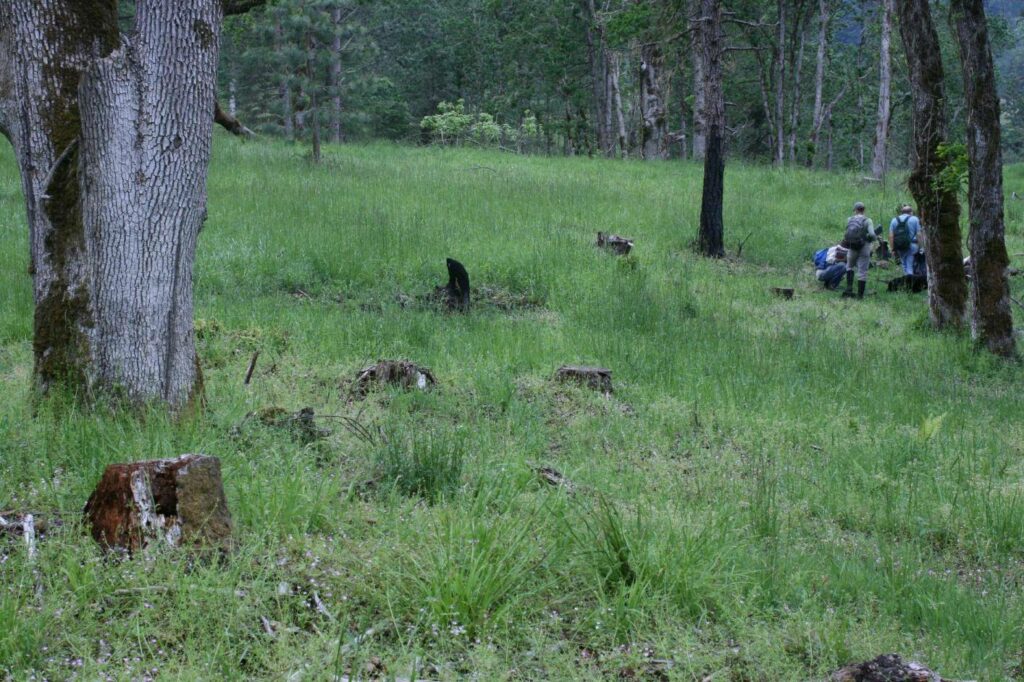
Our first oak restoration project, completed in 2007, occurred in a five-acre stand where oak trees were overtopped by fir and little sunlight reached the forest floor. Conifers competing directly with the oak were removed and other fir and pine trees were thinned to a wide spacing. This produced about 10 loads of logs for the mill. Today this stand contains vigorously growing oak, fir, pine and understory grasses and wildflowers that were absent before restoration.
During the period from 2008 to 2010, we worked on a FWS Landowner Incentive Program grant to restore oak savanna on many acres of oak stands that had been overrun with fir. The ability to sell the fir logs removed from these stands was fortuitous, since all the scattered fir trees that were left after treatment have subsequently died from drought. This grant culminated with a 25-acre prescribed burn and replanting of the burned area with native forbs.
After the blackberries were gone, we found that tall fescue and other nonnative grasses dominated most of our meadow and oak savanna areas. In the past eight years, we have built up a herd of approximately 20 Scottish Highland cattle to help us restore these areas and provide some supplemental income. Managed grazing of the non-native grasses can release the native forbs and wildflowers and may mimic
the effect of wildfire. Grazing also substantially reduces s wildfire risks. We rotate the cattle through several pastures and vary the time we graze each pasture to maintain range health. In 2019, we hosted an agroforestry tour sponsored by Oregon State University to demonstrate how we were melding grazing with timber management and conservation.
Kincaid’s lupine, listed as threatened, is indicative of native prairie and has been found on both our property and adjoining Bureau of Land Management (BLM) land. This plant is the primary host plant for the endangered Fender’s blue butterfly, which was first identified on our property in 2006. To protect and restore these species, the BLM designated the “Oak Basin Area of Critical Environmental Concern.” In 2009, the BLM and Oak Basin tree farm received a grant to jointly restore these lands. Jean Jancaitis of The Nature Conservancy was instrumental in helping us obtain this grant.
Conifer encroachment had significantly reduced the size of many meadows and had isolated some meadows. Our first restoration work involved hand cutting, piling and burning invasive conifers, while creating open corridors to connect the meadows. Larger trees were limbed, girdled or topped in this process. Other work involved identifying and nurturing existing lupine patches and promoting nectar species required by adult butterflies. With this grant we also restored 30 acres of oak woodlands. The income obtained by selling the cut conifer logs was then plowed back into the work. We have subsequently worked on two more grants with the BLM and are now applying for another grant to further enhance our corridors between the upland prairies.
Because of federal regulations, the BLM has not been allowed to use herbicides in their restoration efforts. In contrast, we use selective herbicides to control tall fescue and other invasive species in and around the lupine patches. The result has been a remarkable increase in the size and vigor of our patches. With the help of the Institute of Applied Ecology, we have also reestablished small lupine patches between our existing patches. The BLM is currently developing an Environmental Assessment that would allow the judicious use of herbicides, prescribed burning and other treatments to restore this habitat. Our desire is to do future restoration work across all suitable habitats without regard to property boundaries.
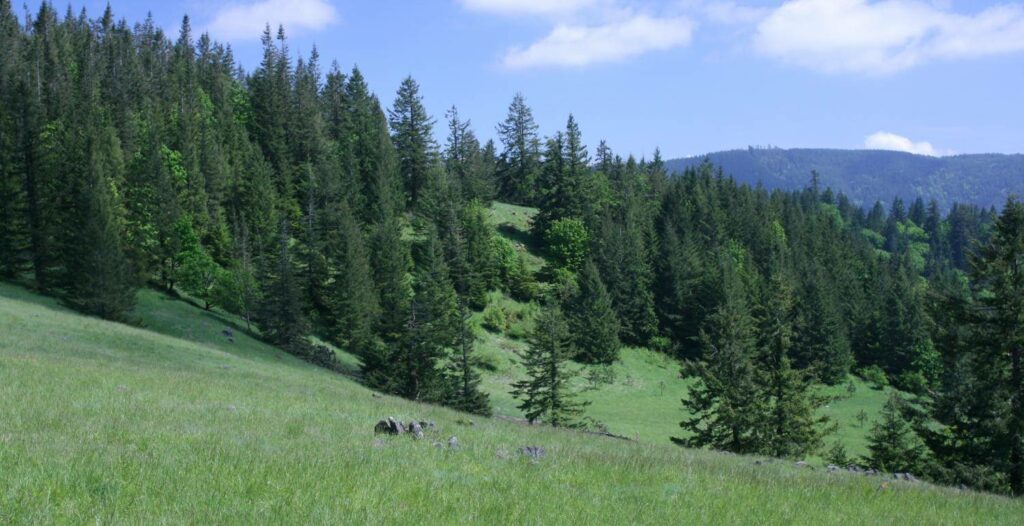
For the past 10 years, we have received grants from the Natural Resource Conservation Service (NRCS) supporting forestry projects that benefit wildlife. Typically, these grants pay us a dollar amount per acre as work is accomplished. The grants enabled us to prune and thin nearly 200 acres of conifer plantations, releasing intermingled oak stands. Another grant covered the cost of reforesting our land with native conifers (Douglas-fir and incense cedar) after removing exotic KMX pine. More than 30 acres of overstocked and mostly immature oak stands were thinned and treated in yet another project. Since 2015, we have been in the Conservation Stewardship Program which reimburses us annually for managing our property for wildlife.
We are currently in the process of obtaining a conservation easement for Oak Basin. This easement would ensure that our ecological restoration work is continued and that our property is never subdivided or otherwise developed. This will be a working lands agreement under which our productive forestland is still managed, by us and our heirs, for timber production and forest health.
Many forestland owners are hesitant about seeking assistance from government agencies or conservation groups. Oak woodlands generally grow on the poorest sites that are not economically suitable for timber production. Our restoration of oak and native prairie areas has not seriously affected our ability to manage our productive lands for timber. The presence of an endangered species on our property has enabled us to obtain funding for ecological restoration that would otherwise not have been available. We encourage everyone to identify and manage rare habitats that may occur.
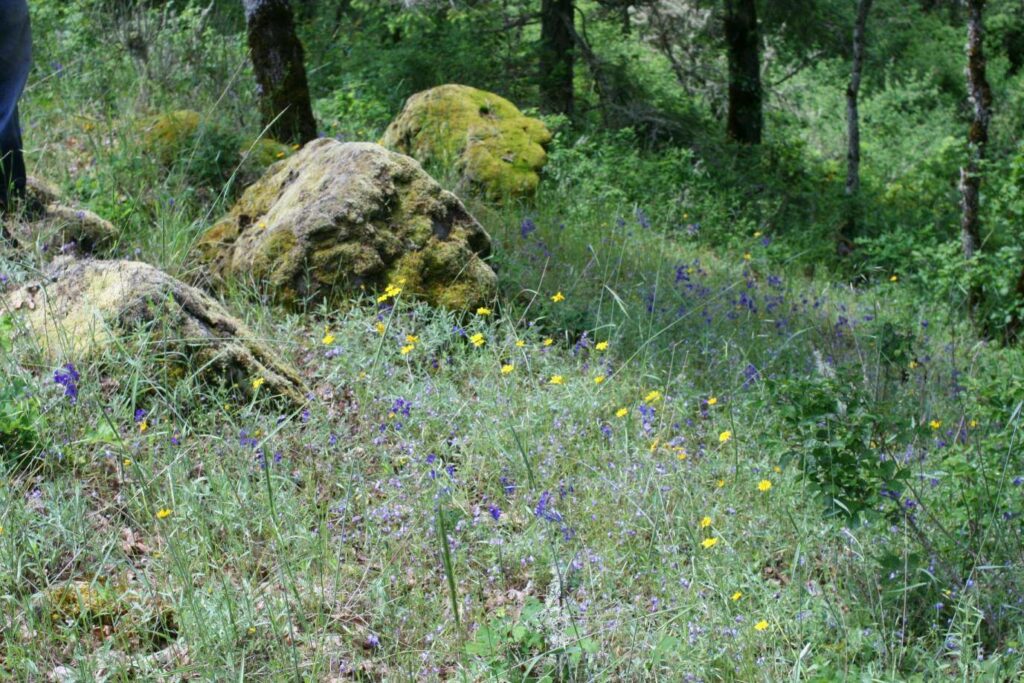
JIM MERZENICH was raised in rural Oregon when nearly everyone worked in !he fields, woods or mills. He earned a BS in zoology from Oregon State University in 1969 (Go Beavs!). After stints in the army and teaching school in Idaho, Jim got a MS in forestry from the University of Montana (Go Griz!). Jim retired in 2010 after 32 years with the US Forest Service. He and his brother bought their first tree farm in 1990 and have been obsessed with tree farming and habitat restoration ever since. Jim can be reached at (541) 466-5004 or jim@oakbasin.com.
This article, by Jim Merzenich of Oak Basin Tree Farm, was first published in the Fall 2020 edition of Northwest Woodlands, a publication of the Oregon Small Woodlands, Washington Farm Forestry, Idaho Forest Owners & Montana Forest Owners Associations. Northwest Woodlands magazine is a benefit of membership in one of these associations – click on the links above to learn more and join! The article is reprinted with permission. Oak Basin Tree Farm is a member of NNRG’s group FSC® certificate.
By Jim Merzenich
Oregon white oak (Quercus garryana) stands are some of the rarest natural habitats in the Northwest. Oak Basin Tree Farm contains some of the largest intact parcels of oak remaining in the Willamette Valley, with some pre-settlement stands exceeding two hundred years of age.
Oak Basin is home to the endangered Fender’s blue butterfly and other rare plant and vertebrate species associated with oak and native prairie. We are actively restoring these areas by removing the competing vegetation, mowing the brush, doing selective cattle grazing and reestablishing native grasses and forbs.

Our primary objective is to demonstrate that a sustainable flow of harvestable timber can be produced from property that is managed for native species protection. We believe that habitat protection is best achieved by active management. We strive to be an example to others that management can be ecologically sustainable while returning profits and services to the landowner.
Soon after my brother Ed purchased the initial Oak Basin acreage, he received a “repair order” from the state of Oregon. As the new owner he was required to immediately reforest over four hundred cutover acres. We proceeded to plant Douglas-fir on the better ground and ponderosa pine on areas that would not support fir. After paying more for reforestation than for the property, Ed was recognized as the Linn County Tree Farmer of the Year in 1998. My wife and I became part owners of Oak Basin when we purchased adjacent timberland in 2004.
When we evaluated our joint properties in 2005, we were ignorant of the importance of oak habitat and wondered what to do with the third of our ownership (over 300 acres) that was in brush and meadows. There was interest in restoring oak woodlands and the U.S. Fish and Wildlife Service (FWS) was the major source of funding.


After consulting with the FWS our first project was mowing and spraying non-native blackberries and hawthorn growing in our meadows and oak stands. We were reimbursed for half of the cost of mowing up to a limit of $10,000 each. With the prickly vines gone, we could suddenly access and use areas that were unknown to us prior to treatment. The change to our landscape was profound and this transformation inspired us to do more. We soon purchased our own Cat® skid steer with mower, grapple and shear attachments and have been busy doing our own restoration.
In 2007, we signed our first “Partners for Wildlife” agreement. In this program, the FWS shares the expenses for ecological restoration activities that benefit wildlife. This has enabled us to restore many acres that were otherwise uneconomical to treat. Our Partners agreement was extended for another ten years in 2019. In 2016, my wife and I were invited to a national meeting in North Platte, Nebraska where we heard from partners managing longleaf pine and red-cockaded woodpeckers in Alabama, cattle and grizzlies in Montana and tall grass prairies in Kansas. The common theme of this meeting was that once-common habitats are now considered rare and valuable.
Prior to European settlement, oak woodlands and native prairie dominated inland valleys of western Oregon and Washington. Due to land conversion and fire suppression, less than five percent of the historic oak and prairie habitat remains. Historically, oak stands were maintained by frequent aboriginal burning, which kept most of the underbrush and fire sensitive trees like Douglas-fir under control. In the absence of fire, Douglas-fir invades these stands and eventually overtops and kills the oak. Noxious shrubs, such as non-native blackberries, hawthorn and Scotch broom invade and dominate the understories. In the native understory, Roemer’s fescue (akin to Idaho fescue), blue wildrye and California fescue are dominant along with poison oak, snowberry and serviceberry.
To restore these stands, we remove the fir, thin the oak and control the brush. Habitat maintenance requires noxious weed control and
periodic burning, when allowed. Grazing may be used to mimic the effect of fire and reduce wildfire risk. Drought resistant conifers, such as ponderosa pine and incense cedar, may be replanted among the oaks in areas that can support them. Oregon white oak generally grows on the poorest sites. The conifer logs taken from these sites are of low quality with high taper and defect. By playing the markets, we have made a small profit removing the fir. We now spend our limited timber management dollars on our productive ground, not on relatively unproductive oak stands.

Our first oak restoration project, completed in 2007, occurred in a five-acre stand where oak trees were overtopped by fir and little sunlight reached the forest floor. Conifers competing directly with the oak were removed and other fir and pine trees were thinned to a wide spacing. This produced about 10 loads of logs for the mill. Today this stand contains vigorously growing oak, fir, pine and understory grasses and wildflowers that were absent before restoration.
During the period from 2008 to 2010, we worked on a FWS Landowner Incentive Program grant to restore oak savanna on many acres of oak stands that had been overrun with fir. The ability to sell the fir logs removed from these stands was fortuitous, since all the scattered fir trees that were left after treatment have subsequently died from drought. This grant culminated with a 25-acre prescribed burn and replanting of the burned area with native forbs.
After the blackberries were gone, we found that tall fescue and other nonnative grasses dominated most of our meadow and oak savanna areas. In the past eight years, we have built up a herd of approximately 20 Scottish Highland cattle to help us restore these areas and provide some supplemental income. Managed grazing of the non-native grasses can release the native forbs and wildflowers and may mimic
the effect of wildfire. Grazing also substantially reduces s wildfire risks. We rotate the cattle through several pastures and vary the time we graze each pasture to maintain range health. In 2019, we hosted an agroforestry tour sponsored by Oregon State University to demonstrate how we were melding grazing with timber management and conservation.
Kincaid’s lupine, listed as threatened, is indicative of native prairie and has been found on both our property and adjoining Bureau of Land Management (BLM) land. This plant is the primary host plant for the endangered Fender’s blue butterfly, which was first identified on our property in 2006. To protect and restore these species, the BLM designated the “Oak Basin Area of Critical Environmental Concern.” In 2009, the BLM and Oak Basin tree farm received a grant to jointly restore these lands. Jean Jancaitis of The Nature Conservancy was instrumental in helping us obtain this grant.
Conifer encroachment had significantly reduced the size of many meadows and had isolated some meadows. Our first restoration work involved hand cutting, piling and burning invasive conifers, while creating open corridors to connect the meadows. Larger trees were limbed, girdled or topped in this process. Other work involved identifying and nurturing existing lupine patches and promoting nectar species required by adult butterflies. With this grant we also restored 30 acres of oak woodlands. The income obtained by selling the cut conifer logs was then plowed back into the work. We have subsequently worked on two more grants with the BLM and are now applying for another grant to further enhance our corridors between the upland prairies.
Because of federal regulations, the BLM has not been allowed to use herbicides in their restoration efforts. In contrast, we use selective herbicides to control tall fescue and other invasive species in and around the lupine patches. The result has been a remarkable increase in the size and vigor of our patches. With the help of the Institute of Applied Ecology, we have also reestablished small lupine patches between our existing patches. The BLM is currently developing an Environmental Assessment that would allow the judicious use of herbicides, prescribed burning and other treatments to restore this habitat. Our desire is to do future restoration work across all suitable habitats without regard to property boundaries.

For the past 10 years, we have received grants from the Natural Resource Conservation Service (NRCS) supporting forestry projects that benefit wildlife. Typically, these grants pay us a dollar amount per acre as work is accomplished. The grants enabled us to prune and thin nearly 200 acres of conifer plantations, releasing intermingled oak stands. Another grant covered the cost of reforesting our land with native conifers (Douglas-fir and incense cedar) after removing exotic KMX pine. More than 30 acres of overstocked and mostly immature oak stands were thinned and treated in yet another project. Since 2015, we have been in the Conservation Stewardship Program which reimburses us annually for managing our property for wildlife.
We are currently in the process of obtaining a conservation easement for Oak Basin. This easement would ensure that our ecological restoration work is continued and that our property is never subdivided or otherwise developed. This will be a working lands agreement under which our productive forestland is still managed, by us and our heirs, for timber production and forest health.
Many forestland owners are hesitant about seeking assistance from government agencies or conservation groups. Oak woodlands generally grow on the poorest sites that are not economically suitable for timber production. Our restoration of oak and native prairie areas has not seriously affected our ability to manage our productive lands for timber. The presence of an endangered species on our property has enabled us to obtain funding for ecological restoration that would otherwise not have been available. We encourage everyone to identify and manage rare habitats that may occur.

JIM MERZENICH was raised in rural Oregon when nearly everyone worked in !he fields, woods or mills. He earned a BS in zoology from Oregon State University in 1969 (Go Beavs!). After stints in the army and teaching school in Idaho, Jim got a MS in forestry from the University of Montana (Go Griz!). Jim retired in 2010 after 32 years with the US Forest Service. He and his brother bought their first tree farm in 1990 and have been obsessed with tree farming and habitat restoration ever since. Jim can be reached at (541) 466-5004 or jim@oakbasin.com.

Leave a Reply